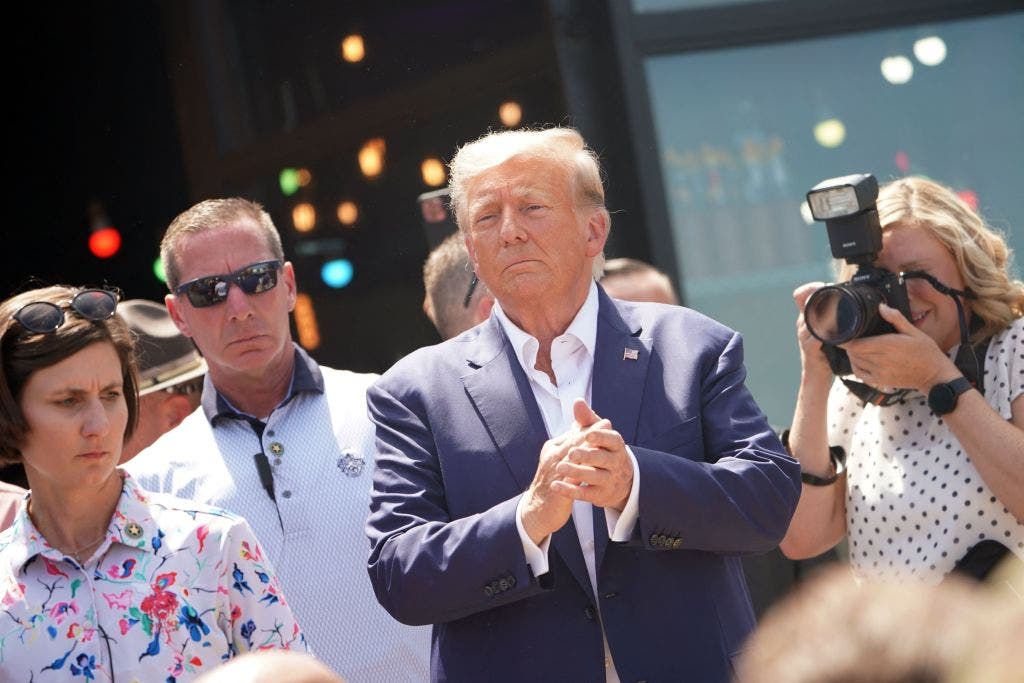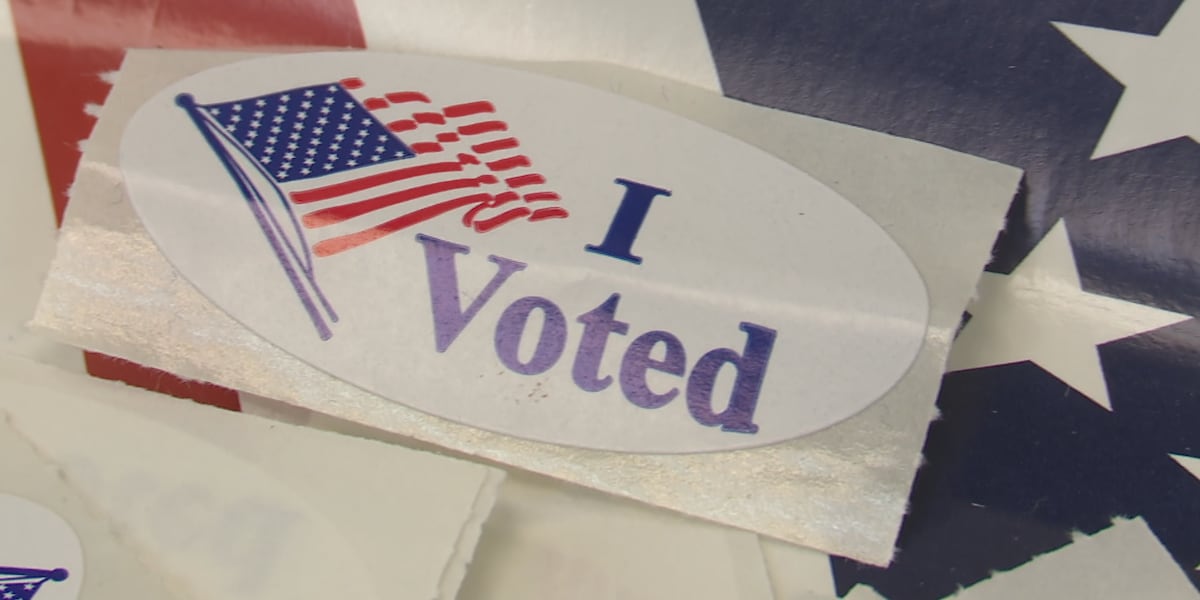In a significant setback for President Donald Trump, new polling data reveals a sharp decline in his approval ratings.
Why It Matters
Trump’s approval rating is a key indicator of his political strength as he navigates his second presidential term and prepares for future policy battles.
A shift in his numbers could influence support from Republican lawmakers, affect his ability to push through his agenda and shape the political landscape heading into the midterm election cycle in 2026.
What To Know
Trump has suffered a quadruple blow in the polls, with four new surveys showing a decline in his approval rating.
The latest Quinnipiac University poll, conducted between April 3-7 shows that Trump’s approval rating among 1,407 registered voters currently stands at 41 percent, while 53 percent disapprove of the way he is handling his job as president. The poll had a margin of error of +/- 3 points.
Alex Brandon/AP
That is down from February, when Quinnipiac’s poll showed that 45 percent approved of Trump, while 49 percent disapproved.
Trump’s average was also down in a YouGov/Economist poll, conducted between April 5-8 among 1,563 registered voters showed that Trump’s overall approval stands at 43 percent, with 51 percent disapproving, for a net approval of -8, which is a 5-point drop from the week before and a 14-point decline since he took office earlier this year. The margin of error for this poll is +/- 3 points.
More bad news came for Trump in Rasmussen’s daily tracker, which shows Trump’s approval rating at 47 points, while his disapproval sits at 52 points. That is Trump’s lowest approval rating with the pollster yet since beginning his second term.
A HarrisX poll conducted between April 4 and 7 among 1,883 registered voters found that Trump’s overall approval rating has dropped 7 points since March 21, 47 percent approving and 49 percent disapproving. The margin of error for the total sample was +/- 2 percentage points.
Newsweek’s tracker also shows Trump’s approval rating at its lowest level yet, with 45 percent approving and 51 percent disapproving, giving him net approval of -6 points.
The decline in Trump’s rating is mainly being driven by voters’ dissatisfaction with the economy, especially since he announced his “Liberation Day” tariffs on April 2, which included a sweeping 10-percent baseline tariff on all imports and harsher duties—ranging from 11 to 100 percent—targeted at what the White House called the “worst offenders” of unfair trade practices.
The announcement immediately shook financial markets, Wall Street suffering its worst single-day performance since the early days of the COVID-19 pandemic in 2020.
Although markets rebounded earlier this week, Trump announced a surprise 90-day pause on most reciprocal tariffs just hours after they took effect on Wednesday. The 10-percent baseline tariff remains in place, and Trump has now raised duties on Chinese imports to 125 percent after Beijing responded with an 84-percent surcharge on U.S. goods.
But despite the partial pause, polling data suggests the damage to Trump’s public standing may already be done.
| Poll | Date | Approve | Disapprove |
| Rasmussen | April 10 | 47 | 52 |
| YouGov/Economist | April 5-8 | 43 | 51 |
| Harris X | April 4-7 | 47 | 49 |
| Morning Consult | April 4-6 | 46 | 52 |
| Quinnipiac | April 3-7 | 41 | 53 |
| Navigator Research | April 3-7 | 44 | 53 |
| Cygnal | April 1-3 | 47 | 51 |
| J.L. Partners | April 1-3 | 47 | 42 |
| Reuters/Ipsos | March 31-April 2 | 43 | 53 |
| Marquette | March 17-27 | 46 | 54 |
The latest Harris X poll reveals a sharp decline in public support for Donald Trump’s handling of the economy and inflation. On March 21, 50 percent of respondents approved of his economic management, and 48 percent backed his stance on inflation. However, recent polling shows those numbers have dropped to 44 and 43 percent, respectively.
Public sentiment about the broader economic situation has also worsened. Now, 54 percent of voters believe the economy is on the wrong track, up from 48 percent just two weeks ago, and 66 percent describe the economy as weak, an increase from 58 percent.
Economic anxiety is growing on a personal level as well, with 38 percent of voters reporting that their financial situation is worsening, compared to 31 percent at the start of the month.
There is also widespread concern about the impact of tariffs. According to the Harris X poll, 72 percent of Americans believe the new tariffs will increase the cost of goods they regularly purchase, and 71 percent expect the duties to cause a short-term recession. The poll has a margin of error of +/- 2 points.
The YouGov/Economist poll has similar findings. Trump’s net approval on economic issues has slipped to -10, down from -4 two weeks ago. On inflation and prices, 55 percent disapprove of his handling, including 19 percent of his own 2024 voters, while only 36 percent approve, resulting in a net approval rating of -19, down from -8.
Public skepticism about the tariffs remains high. Fifty-five percent of respondents believe the new policies will negatively impact their own financial well-being, while just 16 percent think they will help. Additionally, 53 percent say the tariffs will harm the overall U.S. economy, only 31 percent expecting any benefit.
A striking 80 percent of Americans expect the tariffs to raise consumer prices, 47 percent predicting a significant increase and 33 percent expecting a more modest rise. This poll has a margin of error of +/- 3 points.
Meanwhile, Quinnipiac’s poll shows that 40 percent of voters approve of Trump’s handling of the economy, while 55 percent disapprove. This marks a slight decline from their March poll, which recorded 41 percent approval and 54 percent disapproval. On trade, 39 percent of voters approve of Trump’s approach, compared to 55 percent who disapprove, a slight drop from Quinnipiac’s February poll (42 percent approval, 49 percent disapproval).
The poll also shows that a vast majority of voters (72 percent) think the tariffs will hurt the U.S. economy in the short-term, while a smaller majority (53 percent)
think the tariffs will hurt the U.S. economy in the long-term as well.
“A large majority of voters acknowledge the tariffs are delivering a bruising body blow to the economy in the near term. Will time reduce the pain? Some think it will, but a majority don’t envision that happening,” said Quinnipiac University Polling Analyst Tim Malloy.
All three polls were conducted before Trump paused most of the reciprocal tariffs, but they align with other surveys since his April 2 announcement, all showing significant declines in his approval ratings, particularly regarding economic issues.
Thomas Gift, an associate professor of political science and director of the Centre on U.S. Politics at University College London, told Newsweek that Trump’s handling of the tariff situation has alienated many voters.
“Trump hasn’t earned himself many supporters with his handling of the tariff situation. It’s not only the policy that seems to irk voters, but also the apparent lack of strategy, the impulsive decision-making, and the inconsistent messaging from the White House. Trump has long built his brand on being a master dealmaker and a savvy businessman. However, the last several days have dealt a serious huge blow to that image,” he said.
He added that while reviving his economic approval numbers isn’t impossible, Trump has certainly dug himself a deep hole—and climbing out may require not just a plan, but also a fair bit of luck.
How Trump’s Approval Rating Compares to Joe Biden’s
Trump’s 45 percent approval rating is lower than Joe Biden’s popularity at the same point in his presidency on April 10, 2021, when he stood at 55 percent, with a disapproval rating of 40 percent, according to RealClearPolitics.
Polls released in the days after Trump’s inauguration showed his popularity at an all-time high. However, he was still the least popular president in recent times.
According to Gallup’s first poll of Trump’s second term, conducted between January 21 and 27, his initial approval rating was 47 percent. The pollster said this figure made him less popular than any president since 1953 at the start of a term and the only one to begin with a sub-50 percent approval rating. Gallup said Biden started his first term with a 57 percent approval rating.
How Trump’s Approval Rating Compares to First Term
The RealClearPolitics tracker shows that on April 10, 2017, Trump’s approval rating was 40 percent, while his disapproval rating was 53 percent, giving him a net approval rating of -13 points, making Trump more popular now than at the same point in his first stint in the Oval Office.
What Happens Next
Trump’s approval rating could fluctuate in the coming weeks, depending on the outcome of key events, including critical negotiations in the Russia-Ukraine war, the growing tariff battle and concerns about a recession.













